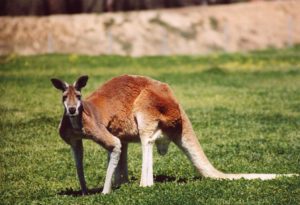King Kangaroo
Genesis 1:25
“And God made the beast of the earth after his kind, and cattle after their kind, and every thing that creepeth upon the earth after his kind: and God saw that it was good.”
 Australia, as we have frequently noted, is a land of exotic animals. And of all the strange and wonderful creatures of that continental country, perhaps none captures the imagination so much as the mighty kangaroo and its smaller cousin the wallaby. Although it’s native to Australia, I remember as a child being fascinated by the mysterious sightings of wallabies in England’s Peak District National Park, which was very close to where I grew up. A colony of sixty had, by 1975, grown from five individuals that had escaped from a zoo in 1940.
Australia, as we have frequently noted, is a land of exotic animals. And of all the strange and wonderful creatures of that continental country, perhaps none captures the imagination so much as the mighty kangaroo and its smaller cousin the wallaby. Although it’s native to Australia, I remember as a child being fascinated by the mysterious sightings of wallabies in England’s Peak District National Park, which was very close to where I grew up. A colony of sixty had, by 1975, grown from five individuals that had escaped from a zoo in 1940.
Kangaroos are marsupials. Though many species of marsupials – mostly opossums – live in the Americas, Australia and New Guinea are replete with a wide variety of them. The main distinguishing feature of a marsupial is that the female gives birth to its young at a very early stage of gestation (about 36 days), and the baby is then sheltered, usually in a pouch, where it continues its development. A baby kangaroo, or joey, will be in its mother’s pouch for about nine months before it begins to venture out for short periods. One fascinating feature of the reproductive cycle is that a female kangaroo can have one embryo in its womb and a developing joey in its pouch. It seems to be able to freeze the development of the embryo and restart it when the joey is ready to leave the pouch. It would seem that God designed this mechanism to allow for the long migration of such marsupials to Australia after the Flood. Author: Paul F. Taylor
Thank You, Lord, for the amazing way in which You have designed creatures such as the kangaroo to have the ability to adapt to their environment. Amen.
Ref: Creation 10(4):8–13—September 1988. Image: Public Domain.